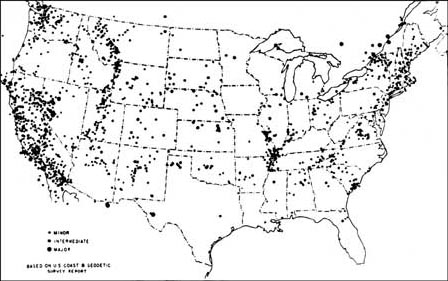|
YELLOWSTONE NATURE NOTES
|
| Vol. XXXIII |
June, 1960 |
Special Edition |
|
THE CAUSES OF EARTHQUAKES
Earthquakes are a common everyday event. About one
million shocks are registered annually around the world, but of this
number only a few are of strong intensity. One need only observe a
mountain terrain to note that the uplift of mountains and plateaus, the
offsetting of river courses, and other physiographic changes have been
accompanied by shifts of the earth's crust resulting in earthquakes.
These have been common happenings extending throughout geologic time.
The planet we inhabit is a dynamic object. Gradational processes of
weathering and erosion attempt to plane off the earth's surface to the
ultimate base level of erosion which for all practical purposes may be
regarded as sea level. From the Mississippi River Basin alone there is
over one million tons of sediment removed and dumped into the Gulf of
Mexico every twenty-four hours. Extend this erosion concept into the
geologic past and one can see that the earth would have been
base-leveled millions of years ago and the oceans would now cover the
earth were there not restorative forces within that periodically
rejuvenate the surface.
The ultimate source of these forces is still not
entirely understood. Some geologists believe in the thermal contraction
theory which implies that as the earth cools from its initial molten
stage, the crust adjusts to the contracting core by wrinkling and
fracturing. A comparison could here be drawn to the wrinkled skin of a
dried apple. Other geologists favor the idea of convection currents
rising from the earth's molten core and dragging down portions of the
crust. When dragged horizontally the forces produce squeezing resulting
in mountain building.
Regardless of the ultimate source of the force we
know that this energy is transmitted into, and stored within, the rocks
of the earth's crust. When these rocks are distorted beyond their limit
of strength they yield suddenly along a fracture by a process known as
faulting.
Yellowstone Park is situated in the Rocky Mountains.
The Rockies consist of chain after chain of mountains that have been
uplifted, folded and faulted extensively during the past 70 million
years. Some of the chains are broad flexures with granite cores flanked
by tilted layers of sedimentary rock. Others are composed largely of
volcanic products. Faults of varying magnitude have been mapped
throughout the mountain system. Many of these faults have been quiet
during recorded human history, others have been active since the
Pleistocene, and still others appear to have been dormant for millions
of years. On some faults the movement has been largely vertical caused
by tensile forces, on others a thrusting by compression is apparent.
Earthquakes in historic times have centered largely
in areas of mountain building and their epicenters are frequently
coincident with the position of known faults.

FIG. 1. Earthquakes in the United States through 1957. Reproduced with
perimission of G. P. Woollard (1958).
| 
